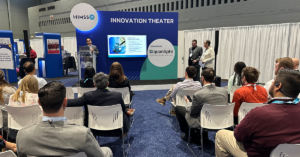Last week’s HIMSS18 conference, the world’s largest health IT conference, brought together 40,000+ of the smartest minds in healthcare to collaborate, showcase new ideas and work together to solve some of the industry’s biggest issues. Similar to last year, Artificial Intelligence (AI) was top of mind at this year’s event. In honor of this trending theme, we connected with our Chief Technology Officer, Tyler Downs, on why AI is such a big focus and what we can expect in the next five years.
If you looked at the HIMSS lineup, most exhibits, sessions and symposiums revolved around this emerging technology. The reason AI is making such a big splash is due to its potential with data. The healthcare industry has endless amounts of data that health systems, both small and large, are dealing with. As reported in the Medical Futurist:
“The amount of available digital data is growing at a mind-blowing speed, doubling every two years. In 2013, it encompassed 4.4 zettabytes, however by 2020 the digital universe – the data we create and copy annually – will reach 44 zettabytes or 44 trillion gigabytes.”
AI helps to properly manage and make use of all this information and that’s why it will hold continued importance in the next five years. Today, we see maybe one percent of the population analyzed with AI. However, in the future, the industry will be able to make sense of larger data sources from various entities to get a holistic picture of the patient. This 360-view will help users make more informed clinical and coverage decisions based on patients’ needs at a broader scale.
To stay ahead of this trend and properly develop AI applications, here’s some advice for healthcare organizations to follow:
1.) Tie data to actions
A big mistake that is often made when building AI applications is not working around the data. Let the data help guide you and always ensure the information connects to an action.
2.) Get on board with security applications
Engage in conversations early and often. This will help to understand who owns what and define a source of truth.
3.) Collaborate and validate
AI applications are not a one-person job – a lot of trial and error is required. Make sure you involve the right people throughout the process to help build and validate your model.
The saturation point with healthcare data is now and the industry needs more solutions to help manage the abundance of information. Data holds the key to the steps the industry needs to take to further connect patients and providers and outline useful information to guide clinical care.
If you’re interested in learning more about HIMSS18 – check out our blogs on the conference here and here. If you’re looking for more insight from Tyler on the power of technology – check out his recent blog on Machine Learning.
Get our take on industry trends
Best practice tools to build an integrated approach to multimorbidity
The traditional model of treating single diseases no longer works. Data collected from 2016 to 2019 indicated that 32.9% of…
Read on...Will adopting a risk-based approach with augmented analytics support care gap closure?
A common challenge for healthcare systems is how to properly segment its patient populations based on risk profiles and co-morbidities. Doing this well ensures a high quality of care delivery and superior patient outcomes.
Read on...4 questions healthcare executives are asking about augmented analytics
At our annual Impact Summit, I had the privilege to talk about augmented analytics and address questions from healthcare executives—many…
Read on...


